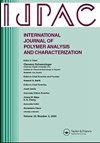Effect of titanium dioxide nanoparticles on the dielectric, thermal, and corrosion resistance properties of polyimide (PI) nanocomposites
IF 1.6
4区 工程技术
Q4 POLYMER SCIENCE
International Journal of Polymer Analysis and Characterization
Pub Date : 2024-10-02
DOI:10.1080/1023666X.2024.2394225
引用次数: 0
Abstract
In the present study, the effect of varying titanium dioxide (TiO2) nanoparticles on the dielectric, thermal, and corrosion characteristics of PI-based composites prepared by spark plasma sintering was investigated. The results obtained revealed that the TiO2 nanoparticles were uniformly dispersed within the PI matrix. Addition of TiO2 into the neat PI markedly reduced its dielectric constant and electrical conductivity by 72.7% and 82.3%, respectively, as well as enhancing its breakdown strength by 16.7% at 8 wt% TiO2 loading. The nanocomposites depict better thermal stability and heat-resistance index characteristics when compared to the PI. Additionally, the produced nanocomposites exhibit improved corrosion resistance than that of the neat PI. The remarkable improvement in the dielectric, thermal stability, and corrosion resistance of the nanocomposites is achieved by better dispersion of the TiO2 particles in the polymer matrix. The enhancement in properties suggests TiO2/PI-based nanocomposites potential for a variety of applications in electrical insulation, thermal management, and harsh environment.
二氧化钛纳米粒子对聚酰亚胺 (PI) 纳米复合材料介电性能、热性能和耐腐蚀性能的影响
在本研究中,不同的二氧化钛(TiO2)纳米粒子对火花等离子烧结法制备的聚氨酯基复合材料的介电、热和腐蚀特性的影响...
本文章由计算机程序翻译,如有差异,请以英文原文为准。
求助全文
约1分钟内获得全文
求助全文
来源期刊
CiteScore
3.50
自引率
5.30%
发文量
37
审稿时长
1.6 months
期刊介绍:
The scope of the journal is to publish original contributions and reviews on studies, methodologies, instrumentation, and applications involving the analysis and characterization of polymers and polymeric-based materials, including synthetic polymers, blends, composites, fibers, coatings, supramolecular structures, polysaccharides, and biopolymers. The Journal will accept papers and review articles on the following topics and research areas involving fundamental and applied studies of polymer analysis and characterization:
Characterization and analysis of new and existing polymers and polymeric-based materials.
Design and evaluation of analytical instrumentation and physical testing equipment.
Determination of molecular weight, size, conformation, branching, cross-linking, chemical structure, and sequence distribution.
Using separation, spectroscopic, and scattering techniques.
Surface characterization of polymeric materials.
Measurement of solution and bulk properties and behavior of polymers.
Studies involving structure-property-processing relationships, and polymer aging.
Analysis of oligomeric materials.
Analysis of polymer additives and decomposition products.

 求助内容:
求助内容: 应助结果提醒方式:
应助结果提醒方式:


